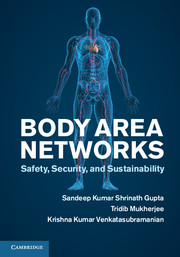Book contents
Preface
Published online by Cambridge University Press: 05 April 2013
Summary
Over the last decade, developments in miniaturization and low-powered electronics have led to the development of wireless sensor networks (WSNs), which are computational systems with the ability not only to sense their environments, but also to process and communicate the data obtained using a wireless channel. This book focuses on a specific class of WSNs, called body area networks (BANs) (also known in the literature as body sensor networks), which are networks of wireless sensors worn on or implanted within the human body and have the potential to revolutionize healthcare by enabling anytime and anywhere health monitoring and actuation. Already a plethora of applications for BANs is being developed for a variety of settings in order to provide managed care both for chronic and for acute conditions. For example, BANs have been developed for monitoring soldiers on the battlefield, managing patients in forward locations in a disaster-hit region, emergency management, elder care, and rehabilitation purposes. However, in order for these applications to be viable in the long run, it is necessary to design BANs to be safe in terms of not causing harm to the users, sustainable without requiring frequent battery replacements, and secure from clandestine eavesdropping or interference. These are particularly challenging problems given the complexity of BANs and the limited computational and communication resources available at the devices/sensors in the BANs.
- Type
- Chapter
- Information
- Body Area NetworksSafety, Security, and Sustainability, pp. xv - xviPublisher: Cambridge University PressPrint publication year: 2013



